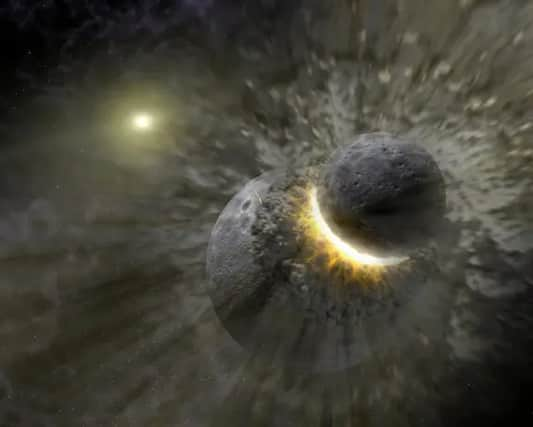How the Moon was made - rock from Theia protoplanet that smashed into Earth may still be in its mantle


The two mysterious continent-sized blobs that reside more than 1,000 miles underground, may be remnants of a protoplanet which slammed into Earth in the early solar system and later formed the Moon.
Researchers say the Moon was created around 4.5bn years ago when a Mars-sized planet called, Theia, crashed into the infant-sized Earth - which was only around 85% of its size today. The collision would have reformed the Earth after melting the two objects together, and the debris blasted into orbit and came together to form the Moon.
Advertisement
Hide AdAdvertisement
Hide AdNow a team of international researchers looked at the two blobs, known as large low-velocity provinces or LLVPs that are buried beneath Africa and the Pacific Ocean to try and figure out their origins. The researchers ran computer simulations examining the impact event, geophysical properties of the material that likely made up Theia and the evolution of Earth's mantle - the broadest of the layers that comprise our planet's interior structure at about 1,800 miles (2,900 km) thick, and proposed most of Theia was absorbed into Earth, forming the blobs, while residual debris formed the Moon.
"The bottoms of these blobs are 2,900 kilometres below our feet. The two blobs are about 2% of Earth's mass. They were detected by seismology as seismic waves travel slower within these two regions compared to the surrounding mantle. Each of the blobs are twice the mass of the whole moon. So, the blobs are massive," said Caltech geophysicist Qian Yuan, lead author of the study published in the journal Nature.
If the study is right, the two blobs would represent elusive evidence right here on Earth of the hypothesized moon-forming collision.
"There hasn't been much consensus on whether we can find evidence for this event not just in the moon but also in some observable property of the modern Earth," Caltech geology and geochemistry professor and study co-author Paul Asimow said.
Advertisement
Hide AdAdvertisement
Hide AdThe two blobs, Asimow added, "are the biggest deviations in Earth structure from a simple layered planet." The increased density of the blobs are thought to have rise from their high level of iron, similar to moon rocks, which adds up if they are made of the same source material from Theia.
"After the impact, these impactor materials would sink down to the core-mantle boundary because they likely have higher density than ambient mantle, and it is the extra density that allows them to survive Earth's whole history. If our model is correct, the blobs should have isotopes - trace elements - that are similar to the lunar mantle rocks, which can be tested in future lunar missions," Yuan said.
He added: "Earth is still the only confirmed habitable planet, and we do not know why," Yuan said. "This collision likely set the initial condition of Earth's evolution. Studying its consequences may help us to figure out why Earth is different than other rocky planets."
Comment Guidelines
National World encourages reader discussion on our stories. User feedback, insights and back-and-forth exchanges add a rich layer of context to reporting. Please review our Community Guidelines before commenting.
